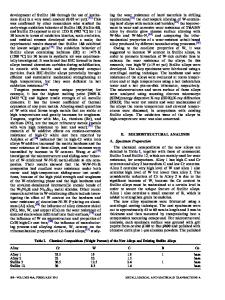Effects of elevated temperature annealing on the structure and hardness of copper/niobium nanolayered films
- PDF / 8,811,660 Bytes
- 9 Pages / 612 x 792 pts (letter) Page_size
- 30 Downloads / 378 Views
We investigated the effects of elevated temperature vacuum annealing on the morphological stability and hardness of self-supported, textured, polycrystalline Cu–Nb nanolayered films with individual layer thickness varying from 15 to 75 nm. Films with layer thickness greater than approximately 35 nm are found to resist layer pinch-off and spheroidization even after long annealing times at 700 °C, while films with layer thickness ∼15 nm exhibit layer pinch-off and evolve into an equiaxed grain microstructure. Nanoindentation measurements indicate almost no change in hardness after annealing for films that retain the layered morphology, in spite of the increase of in-plane grain dimensions. Significant decreases in hardness are noted for films that develop a coarsened equiaxed grain microstructure after annealing. The mechanism that leads to the development of a thermally stable nanolayered structure is analyzed. Also, the relative effects of in-plane grain size and layer thickness on the multilayer hardness are discussed.
I. INTRODUCTION
Multilayered thin films on substrates are used in a variety of applications such as x-ray mirrors, magnetic recording media and heads, diffusion barrier coatings, wear resistant coatings, etc. In addition to coatings on substrates, these high-strength metallic multilayers may also have applications as self-supported components. Recent studies have shown that metallic multilayers, composed of alternating layers of soft metals, possess very high strength when the bilayer periods are on the order of a few to a few tens of nanometers.1–3 Thermal stability of these films has been studied mostly for the instability mechanisms involving interdiffusion in miscible layers, chemical reaction to form a new phase/compound, or phase transformation (e.g., amorphous to crystalline).4–6 The morphological stability and strength retention following elevated temperature exposure or thermal cycling is of concern if the unusual properties of these nanolayered materials are to be exploited in advanced engineering applications. Most studies of the morphological stability of fiber7 or lamellar8,9 composites have been conducted on materials where the microstructural features have dimensions on the order of micrometers. These studies show that although lamellar composites are more stable than fiber
a)
Address all correspondence to this author. e-mail: [email protected] DOI: 10.1557/JMR.2005.0250 2046
http://journals.cambridge.org
composites, significant morphological instabilities may still occur in layered materials such as pearlitic steels, ␥/␣2 titanium aluminides, rolled Ni–W, and Cu–Ag.8–10 Recently, Josell et al.11–14 studied the stability of micrometer- or submicrometer-scale multilayered films, primarily through creep testing, and observed layer pinch-off due to grain boundary grooving as a major instability mechanism. Limited work on nanoscale multilayers has shown a more serious thermal stability problem even for immiscible systems such as Cu/Ta,3 Cu/Nb,15 Cu/Ag,16 and Cu/Co.17 For example, Troc
Data Loading...










